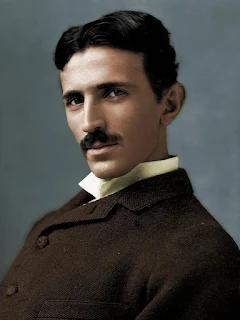"Tesla's Technological Triumphs: A Legacy Unveiled"
Nikola Tesla, a name that resonates with innovation, brilliance, and a relentless pursuit of scientific advancement. Often overshadowed by contemporaries like Thomas Edison, Tesla's contributions to modern technology are undeniable, shaping the world as we know it today. From alternating current (AC) electricity to wireless communication, Tesla's inventions continue to influence countless aspects of our lives. In this blog post, we'll delve into some of Tesla's most groundbreaking inventions and explore their enduring impact on society.
1. Alternating Current (AC) Electricity:
Arguably Tesla's most significant contribution to modern civilization, alternating current revolutionized the way electricity is transmitted and distributed. Unlike direct current (DC), which Edison championed, AC allows for the efficient transmission of electricity over long distances, making it the preferred method for powering homes, businesses, and industries worldwide. Tesla's AC induction motor, coupled with his patents for AC generators and transformers, laid the foundation for the electrification of the modern world.
2. Tesla Coil:
The Tesla coil, a high-voltage, air-core, resonant transformer, is not only a marvel of engineering but also an essential component in many modern technologies. Initially developed for experiments in wireless power transmission and radio communication, Tesla coils are now widely used in applications ranging from medical equipment (such as MRI machines) to entertainment (like Tesla coil music performances) and even in educational demonstrations.
3. Wireless Communication:
Long before the advent of smartphones and Wi-Fi, Nikola Tesla envisioned a world connected by wireless communication. Tesla's experiments with radio waves paved the way for the development of wireless telegraphy, laying the groundwork for future innovations in radio, television, and eventually, the internet. While Guglielmo Marconi is often credited with the invention of radio, Tesla's pioneering work in this field cannot be overlooked.
4. Tesla Turbine:
The Tesla turbine, a bladeless centripetal flow turbine, represents Tesla's innovative approach to harnessing energy from fluids. Unlike traditional turbines with blades, the Tesla turbine operates using smooth, parallel disks, offering advantages such as simplicity, reliability, and scalability. Although not as widely adopted as some of his other inventions, the Tesla turbine has found applications in fields such as marine propulsion, pump systems, and renewable energy generation.
5. Wardenclyffe Tower:
One of Tesla's most ambitious projects, the Wardenclyffe Tower, aimed to demonstrate the feasibility of wireless power transmission on a global scale. Located in Shoreham, New York, the tower was intended to transmit electrical energy without the need for wires, potentially providing free energy to the world. While the project was never completed due to financial difficulties, it remains a testament to Tesla's visionary thinking and his dream of a world interconnected by wireless technology.
6. Tesla's Death Ray:
Among Tesla's lesser-known inventions is the concept of a "death ray," a theoretical weapon designed to emit concentrated beams of energy capable of destroying enemy targets from a distance. While Tesla explored the idea of directed energy weapons for defensive purposes, he never fully developed a working prototype. Nonetheless, his theories laid the groundwork for later advancements in laser and particle beam technology, influencing military research in the decades following his death.
7. Remote Control:
Tesla's pioneering work in remote control technology paved the way for the development of modern wireless communication and automation systems. His demonstration of a remote-controlled boat at the Electrical Exhibition in Madison Square Garden in 1898 showcased the potential of radio waves to transmit signals over long distances, foreshadowing the future of remote-controlled devices, drones, and robotics.
8. Tesla's Oscillator:
Tesla's mechanical oscillator, also known as the earthquake machine, was an invention designed to produce mechanical vibrations capable of causing buildings and structures to resonate, potentially leading to their collapse. While Tesla claimed that the device could be used for constructive purposes such as finding underground ore deposits or detecting submarines, its destructive potential raised concerns about its misuse, and it was never widely adopted.
9. Tesla Valve:
The Tesla valve, a one-way flow control device based on fluid dynamics principles, represents another of Tesla's ingenious inventions. Unlike traditional valves, which rely on moving parts, the Tesla valve operates using a series of specially designed channels to regulate the flow of fluids. While initially proposed for use in steam engines, the Tesla valve has found applications in various fields, including automotive engineering, aerospace, and fluid dynamics research.
10. Shadowgraph:
Tesla's development of the shadowgraph, a precursor to modern X-ray imaging techniques, demonstrated his interdisciplinary approach to scientific exploration. By passing electric currents through various objects and observing the shadows they cast, Tesla was able to visualize internal structures and detect flaws or defects invisible to the naked eye. While overshadowed by later advancements in radiography, Tesla's contributions to medical imaging laid the groundwork for future innovations in diagnostic medicine.
Nikola Tesla ideas that were stolen by others
Tesla's Financial Struggles:
Despite his numerous inventions and groundbreaking discoveries, Nikola Tesla died impoverished and in relative obscurity. Throughout his career, Tesla prioritized scientific exploration and innovation over financial gain, often reinvesting his earnings into new projects or facing financial setbacks due to failed ventures. Additionally, Tesla's contentious relationships with business partners and investors, coupled with his penchant for extravagant experiments and lavish living, contributed to his financial woes. In his later years, Tesla relied on the generosity of friends and benefactors to support himself, highlighting the tragic irony of a man whose visionary ideas transformed the world but left him struggling to make ends meet.
Conclusion:
Nikola Tesla's legacy extends far beyond the confines of his lifetime, with his inventions continuing to shape the technological landscape of the 21st century and beyond. From electricity and communication to transportation and energy, Tesla's visionary ideas have left an indelible mark on society, inspiring generations of scientists, engineers, and inventors to push the boundaries of what is possible. As we marvel at the wonders of modern technology, let us not forget the genius of Nikola Tesla, whose brilliance illuminated the path to a brighter future for humanity.

Comments